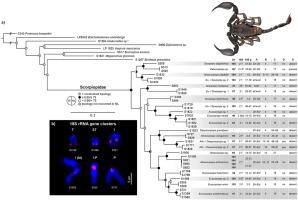Our official English website, www.x-mol.net, welcomes your
feedback! (Note: you will need to create a separate account there.)
Karyotype evolution and preliminary molecular assessment of genera in the family Scorpiopidae (Arachnida: Scorpiones)
Zoology ( IF 1.6 ) Pub Date : 2021-02-01 , DOI: 10.1016/j.zool.2020.125882 František Šťáhlavský 1 , František Kovařík 1 , Mark Stockmann 2 , Vera Opatova 1
Zoology ( IF 1.6 ) Pub Date : 2021-02-01 , DOI: 10.1016/j.zool.2020.125882 František Šťáhlavský 1 , František Kovařík 1 , Mark Stockmann 2 , Vera Opatova 1
Affiliation

|
The scorpions represent an ancient and morphologically conserved order of arachnids. Despite that, their karyotypes may differ considerably even among closely related species. In this study, we identify the trends of the karyotype evolution in the family Scorpiopidae based on integrating cytogenetic data and multi-locus molecular phylogenetic approaches. We detected considerable variability in diploid numbers of chromosomes (from 48 to 147), 18S rRNA gene cluster positions (from terminal to pericentromeric) at the interspecific level. Moreover, we identified independent fusions, fissions and inversions in the evolution of the family Scorpiopidae, leading to a remarkable diversification of the karyotypes. The dynamic system of the karyotype changes in this group is further documented by the presence of interstitial telomeric sequences (ITS) in two species. The cytogenetic differences observed among the analyzed species highlight the potential of this type of data for species-level taxonomy in scorpion lineages with monocentric chromosomes. Additionally, the results of our phylogenetic analyses support the monophyly of the family Scorpiopidae, but rendered several genera para- or polyphyletic.
中文翻译:

蝎科(蛛形纲:蝎科)属的核型进化和初步分子评估
蝎子代表了一种古老的、形态上保守的蛛形纲。尽管如此,即使在密切相关的物种中,它们的核型也可能有很大差异。在这项研究中,我们基于整合细胞遗传学数据和多位点分子系统发育方法确定了蝎形科的核型进化趋势。我们在种间水平上检测到染色体二倍体数量(从 48 到 147)、18S rRNA 基因簇位置(从末端到着丝粒周围)的相当大的变异性。此外,我们在天蝎科的进化过程中发现了独立的融合、裂变和倒位,导致核型显着多样化。两个物种中存在间隙端粒序列 (ITS) 进一步证明了该组核型变化的动态系统。在分析的物种中观察到的细胞遗传学差异突出了此类数据在具有单中心染色体的蝎子谱系中的物种级分类学的潜力。此外,我们的系统发育分析的结果支持天蝎科的单系,但呈现了几个属的副系或多系。
更新日期:2021-02-01
中文翻译:

蝎科(蛛形纲:蝎科)属的核型进化和初步分子评估
蝎子代表了一种古老的、形态上保守的蛛形纲。尽管如此,即使在密切相关的物种中,它们的核型也可能有很大差异。在这项研究中,我们基于整合细胞遗传学数据和多位点分子系统发育方法确定了蝎形科的核型进化趋势。我们在种间水平上检测到染色体二倍体数量(从 48 到 147)、18S rRNA 基因簇位置(从末端到着丝粒周围)的相当大的变异性。此外,我们在天蝎科的进化过程中发现了独立的融合、裂变和倒位,导致核型显着多样化。两个物种中存在间隙端粒序列 (ITS) 进一步证明了该组核型变化的动态系统。在分析的物种中观察到的细胞遗传学差异突出了此类数据在具有单中心染色体的蝎子谱系中的物种级分类学的潜力。此外,我们的系统发育分析的结果支持天蝎科的单系,但呈现了几个属的副系或多系。











































 京公网安备 11010802027423号
京公网安备 11010802027423号